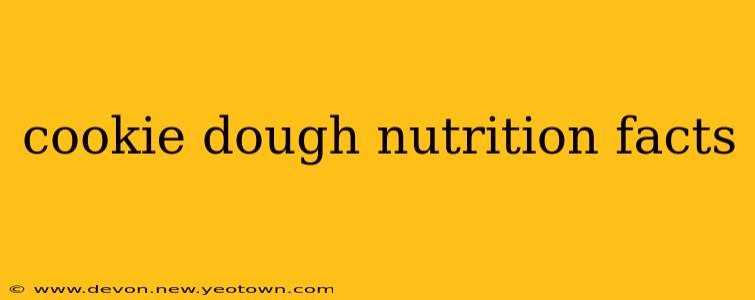Let's be honest, the irresistible allure of cookie dough often overshadows any thoughts of nutrition. But before you dive headfirst into that bowl of sugary goodness, it's worth understanding what exactly you're consuming. This isn't just about calories; it's about understanding the ingredients that make up this beloved treat and how they impact your body. This isn't your average cookie dough nutrition facts rundown; we're going on a culinary adventure, exploring the science behind the scoop.
What are the main ingredients in cookie dough?
The foundation of most cookie dough recipes revolves around a few key players: flour, butter, sugar (often both granulated and brown), eggs, and vanilla extract. Beyond that, you'll often find chocolate chips, nuts, or other additions contributing to the flavor profile and, consequently, the nutritional breakdown. The exact nutritional composition varies wildly depending on the recipe and the specific ingredients used. A vegan cookie dough will differ significantly from one made with traditional ingredients. This variation makes it crucial to always refer to the specific nutrition facts label if available, or calculate it based on your specific recipe.
How many calories are in a serving of cookie dough?
This is the question on many minds! Unfortunately, there's no single answer. The calorie count varies dramatically based on portion size and recipe. A tablespoon of a simple recipe might clock in around 50-70 calories, but a larger serving, or a recipe packed with chocolate chips and nuts, could easily jump to 150-200 calories or more per serving. Remember, that's just a serving – the entire bowl is a much bigger calorie commitment!
Is cookie dough safe to eat raw?
This is a crucial question of food safety, especially concerning eggs. Raw eggs can contain Salmonella, a bacteria that can cause food poisoning. If you're using store-bought cookie dough, many brands utilize heat-treated or pasteurized eggs to minimize this risk. However, homemade cookie dough carries a higher risk if made with raw eggs. Many recipes now use alternatives like flax eggs to eliminate this concern.
What are the potential health risks of eating raw cookie dough?
Beyond Salmonella, there are other potential concerns. Raw flour can harbor E. coli, another bacteria that can lead to illness. While the risk isn't always high, individuals with weakened immune systems should exercise extra caution. The high sugar content in cookie dough is another factor to consider, contributing to potential weight gain and impacting blood sugar levels if consumed in large quantities.
What are the nutritional benefits of cookie dough (if any)?
Let's be realistic: cookie dough isn't known for its extensive health benefits. The primary nutritional contributions come from the flour (carbohydrates, some fiber), butter (fat), and eggs (protein, if cooked). However, these benefits are often overshadowed by the high sugar and fat content. It's best to think of cookie dough as an occasional treat, not a dietary staple.
How can I make healthier cookie dough?
If you're craving the taste but aiming for a healthier option, consider these strategies: reduce the sugar content, use whole wheat flour for added fiber, incorporate more nuts or seeds for healthy fats and added nutrients, and substitute some of the butter with applesauce or mashed banana to reduce fat and add moisture. Using heat-treated or pasteurized eggs is also a crucial step for food safety when making homemade cookie dough.
Remember, moderation is key. Enjoy your cookie dough as a delicious indulgence, but be mindful of portion sizes and the potential health implications of consuming raw ingredients. Always prioritize food safety and consider adapting your recipe for a healthier, safer, and still incredibly delicious treat.

